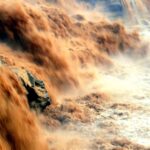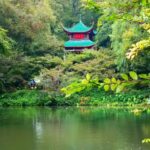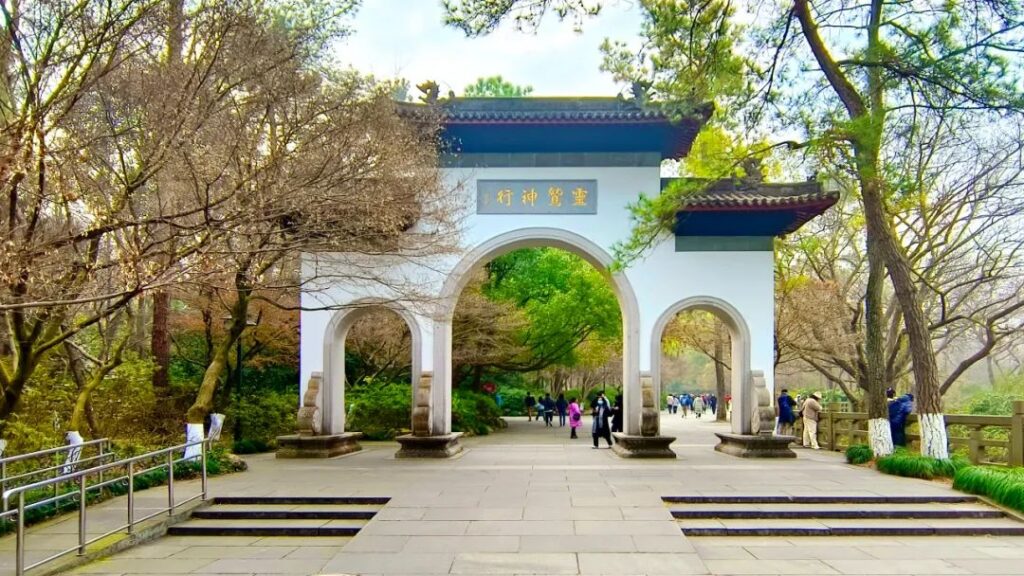
Feilai Peak, also known as Lingjiu Peak, is located in front of Lingyin Temple in Hangzhou, Zhejiang Province, and is a famous tourist attraction in Hangzhou. Although Feilai Peak is not high, the mountain is covered with grotesque rocks, sharp ridges, and lush trees growing between the rocks, making the entire mountain look like an enlarged version of a landscape bonsai. When Su Dongpo was in Hangzhou, he wrote a poem saying, “Every place in the streams and mountains can be a dwelling, but I love Lingyin Feilai Peak the most.”
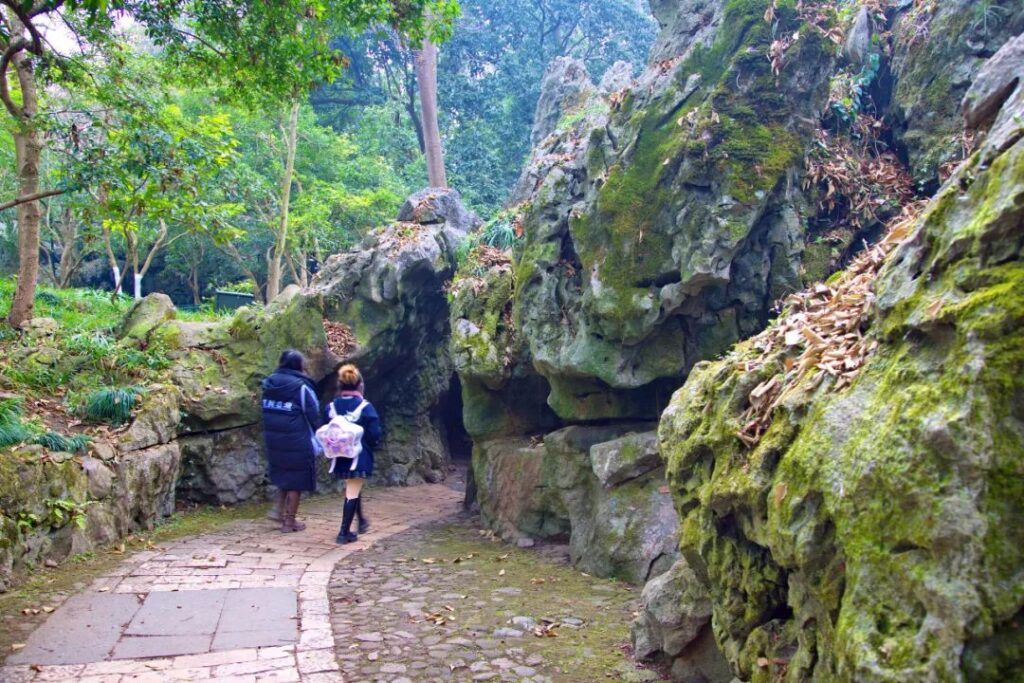
According to research, in ancient times, Hangzhou was still a vast ocean. With the movement of the earth’s crust, it gradually turned into land, and at the same time, the seabed rock layers fractured, with limestone and sandstone interspersed. The sandstone layer, with its strong resistance to corrosion, formed a highland landform; while the soft limestone layer, after long-term weathering and erosion by flowing water, was eroded into a landform with rugged mountain rocks.

There are many legends about Feilai Peak in Hangzhou. Legend one: During the Eastern Jin Dynasty, an Indian monk named Huili came to Hangzhou to preach scriptures. When he saw this mountain, he exclaimed, “This is Vulture Peak in India. How did it fly here?” Seeing that people did not believe him, Huili told the crowd that there were black and white monkeys practicing in the cave. After saying that, he walked to the entrance of the cave and called out the black and white monkeys. Therefore, Huili named this mountain “Feilai Peak” and built Lingyin Temple beside the mountain.
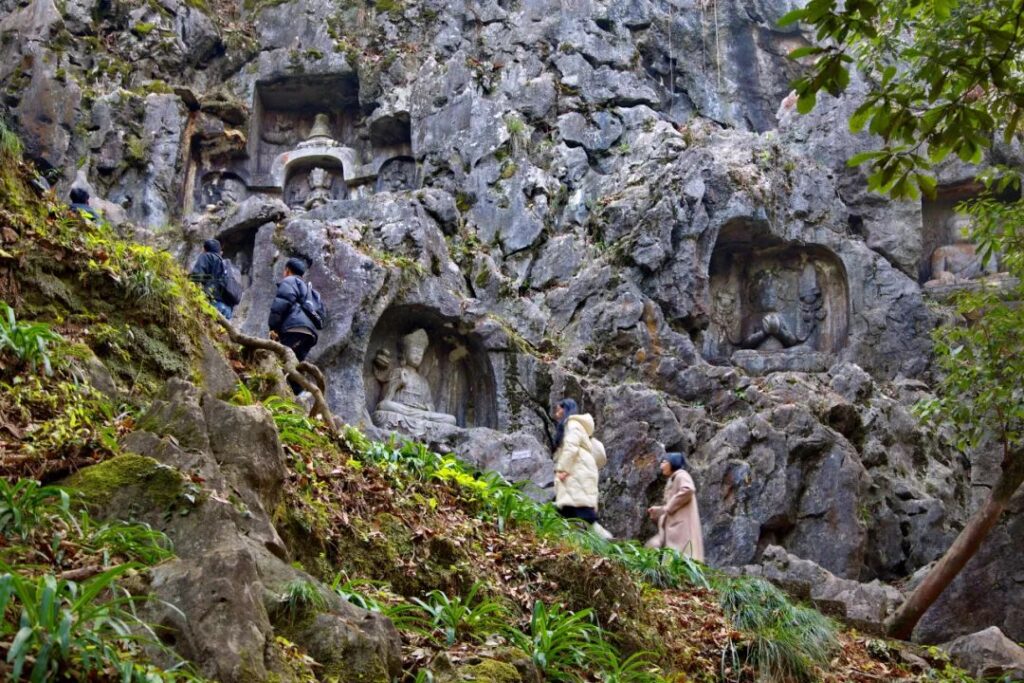
Legend two: Shi Wa and Hua Mei were a couple from Zhuji, Zhejiang. One day, the Thunder God saw the beautiful Hua Mei and wanted to have her. So the Thunder God split the mountain where the two were into two halves, and one half of the mountain carrying Hua Mei fell to Hangzhou. Shi Wa turned into a long-billed bird and came to the front of the mountain to look for Hua Mei. Every day, he pecked at the rocks on the mountain with his beak. The rocks were finally pecked through by Shi Wa, and Hua Mei also turned into a beautiful bird and flew away with Shi Wa.

Legend three: One day, Monk Ji Gong calculated that a mountain peak was about to fly over, so he rushed into the village to persuade the villagers to leave. At that time, a wedding was being held in the village, and no one listened to his advice. So Ji Gong carried the bride on his back and ran away. The villagers saw this and all shouted and chased after Ji Gong. Just as they were chasing, a mountain peak suddenly fell and crushed the village. At this time, the villagers realized that Ji Gong was trying to save them, so they called this mountain “Feilai Peak”.
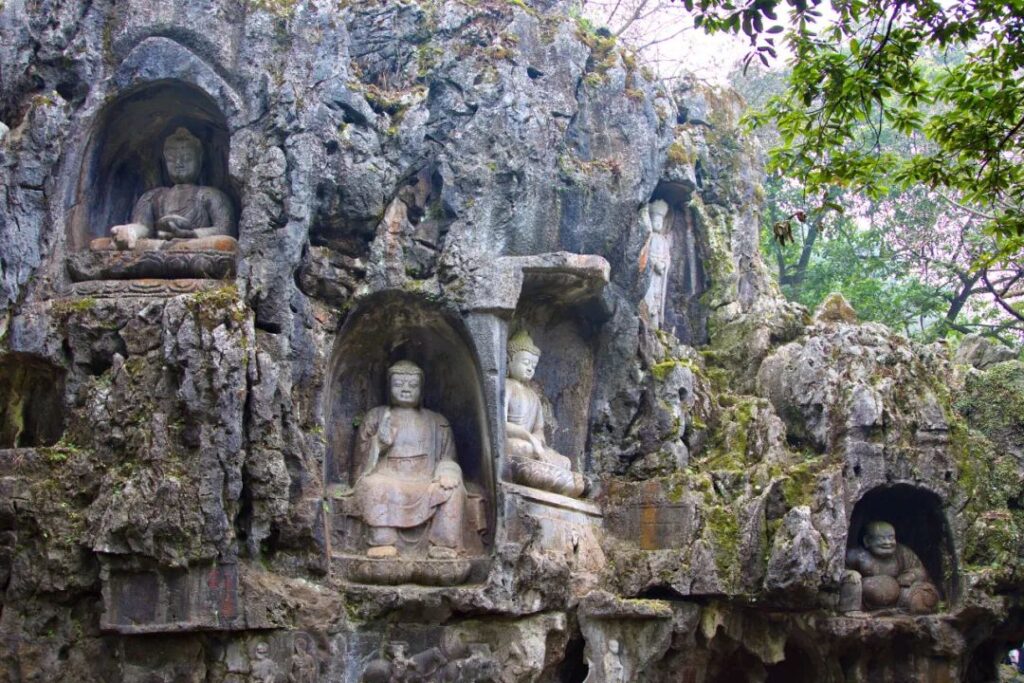
Although Feilai Peak is grotesquely shaped and extremely beautiful, what attracts people the most are the stone cave statues and cliff inscriptions in the caves of Feilai Peak. There are more than 470 statues from the Five Dynasties to the Yuan Dynasty distributed in Feilai Peak, which are rare treasures of ancient stone cave art in the Jiangnan region of China and can be compared with the Dazu Rock Carvings in Chongqing.
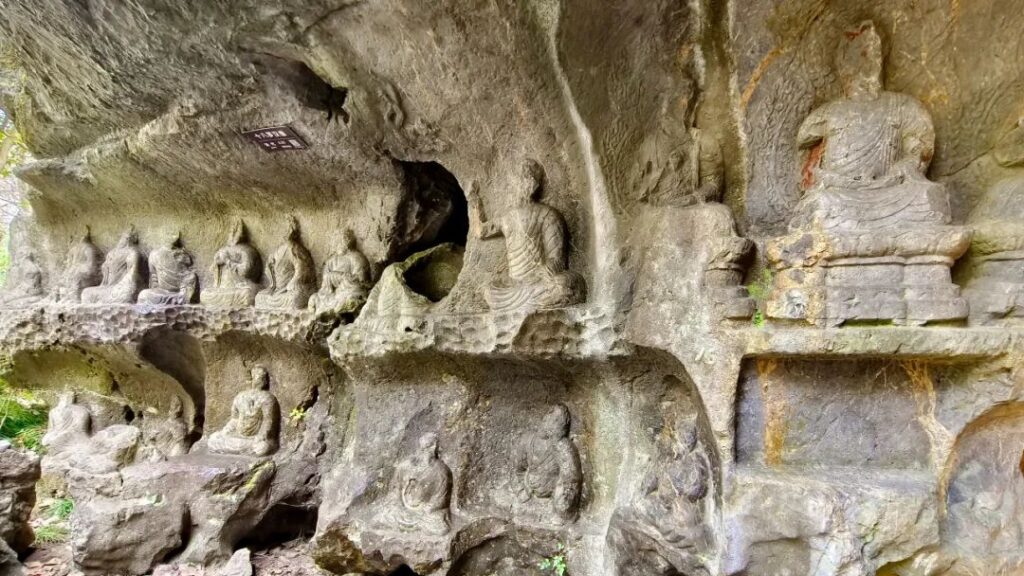
Chinese stone cave art flourished in the Northern Wei Dynasty and reached its peak in the Sui and Tang Dynasties, but few stone caves were preserved after the Five Dynasties, which may be due to the influence of Emperor Shizong of the Later Zhou Dynasty’s destruction of Buddhism. After the incident, a large number of craftsmen went south, and the Buddhist statue art in the north began to decline. At this time, the Qian family had ruled the southeast for several decades, and the political situation was relatively stable. The kings of Wu and Yue for several generations were very devout to Buddhism, laying the foundation for the transfer of stone cave art from north to south.
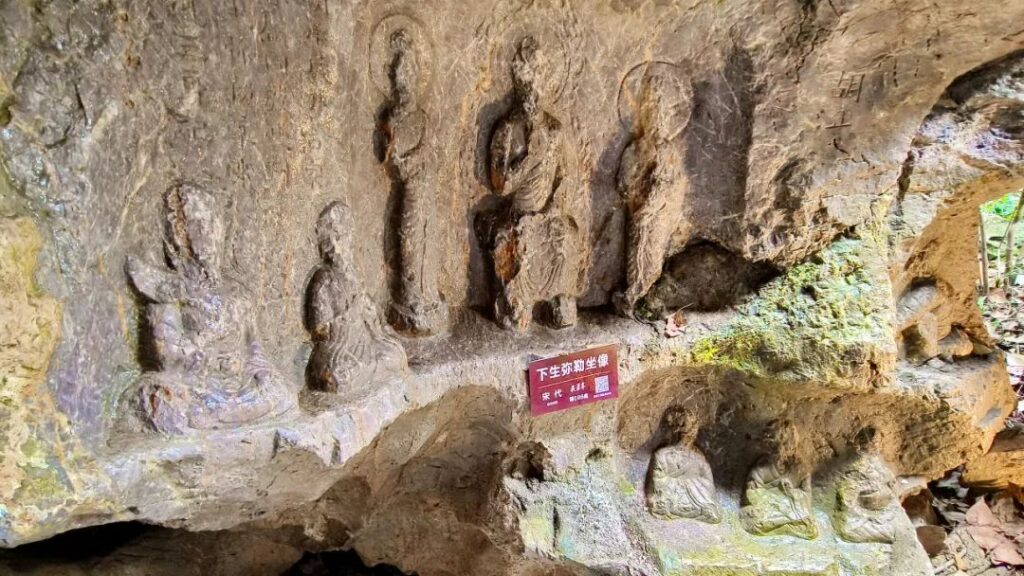
The stone cave statues of Feilai Peak were carved in the late Tang Dynasty and experienced three peak periods of statue making in the Five Dynasties, Song, and Yuan Dynasties. With the changes of history and the evolution of the times, as well as the integration of many ethnic groups, the style of Feilai Peak stone cave statue art also shifted from the gorgeous and full style of the Tang Dynasty to a more secular direction, gradually presenting distinct characteristics of the times, nationalities, and secularization.
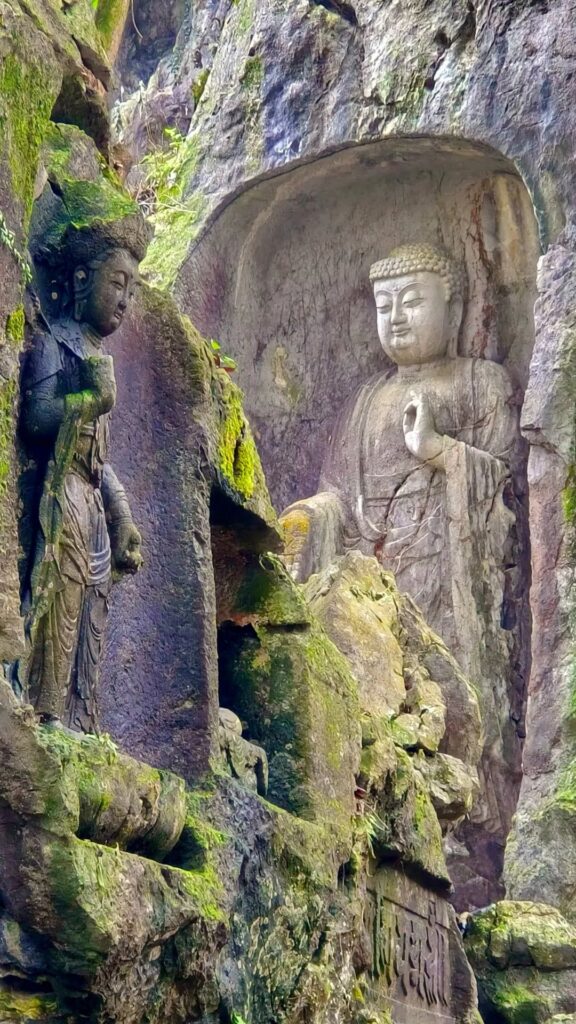
On the east side of Feilai Peak, there are three major caves: Qinglin Cave, Yuru Cave, and Longhong Cave. The stone carvings of Feilai Peak are distributed inside and outside these natural rock caves, as well as on the mountain rocks on the north side of Lengquan Stream. Within this area of about 600 meters long and 200 meters wide, there are more than 150 niches and more than 470 stone carved statues, making it the largest and most famous stone cave statue group in southeastern China.
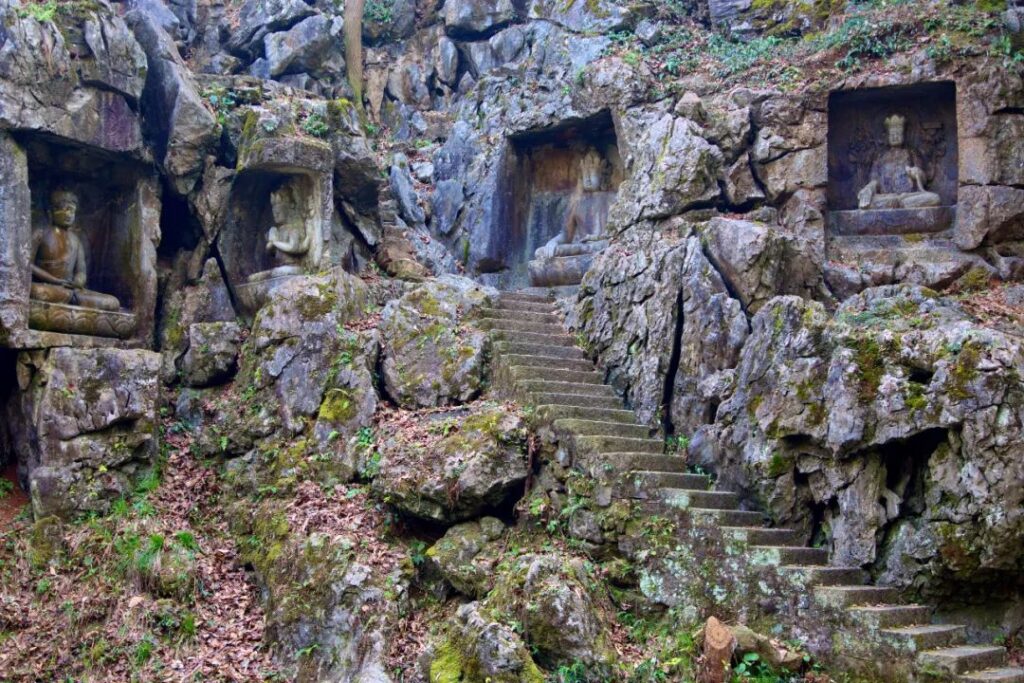
Due to the rugged rocks of Feilai Peak, there are few large flat cliffs. When carving statues, the craftsmen often flattened the rocks before carving niches and statues. Because the rocks of Feilai Peak are relatively hard and difficult to carve, the niches are not deep, and many large statues are exposed outside the niches. Although the distribution of stone carvings appears disorderly, it also has a strong three-dimensional sense.

Among the stone carvings of Feilai Peak, the Northern Song Dynasty statues are the most numerous, with more than 232 statues, mainly distributed in Qinglin Cave and Yuru Cave. The themes are mostly Arhats and patriarchs, but most of them do not have obvious inscriptions. There are about 67 niches and 116 statues from the Yuan Dynasty, mainly distributed on the southern bank of Lengquan Stream and the cliffs around Qinglin Cave and Yuru Cave.

Although the size and number of the Yuan Dynasty statues are second only to the Song Dynasty stone cave statues, they present the characteristics of “displaying both exoteric and esoteric Buddhism, and using both Chinese and Sanskrit”. The reason for this is related to the rule of the Yuan Dynasty over Jiangnan at that time. After the Yuan army occupied Hangzhou, they took measures to strictly control the people and win over the virtuous scholars, and sent Tibetan Buddhist monks to lead Buddhist affairs, elevating Tibetan Buddhism to an extremely high position.

As there are too many stone carvings in the Feilai Peak Grottoes, only a rough introduction will be made here. Qinglin Cave is the largest cave on the southeast side of Feilai Peak. It is also called “Tiger Cave” because the shape of the cave entrance resembles a tiger’s mouth. On the outer wall of the cave entrance, there are carvings of the Three Saints of Huayan, which is the largest statue in Qinglin Cave. This niche of Buddha statues was carved in the Yuan Dynasty. The Three Saints of Huayan are all sitting in half-cross-legged posture, with Sakyamuni Buddha in the middle, Manjusri Bodhisattva on the left, and Samantabhadra Bodhisattva on the right.
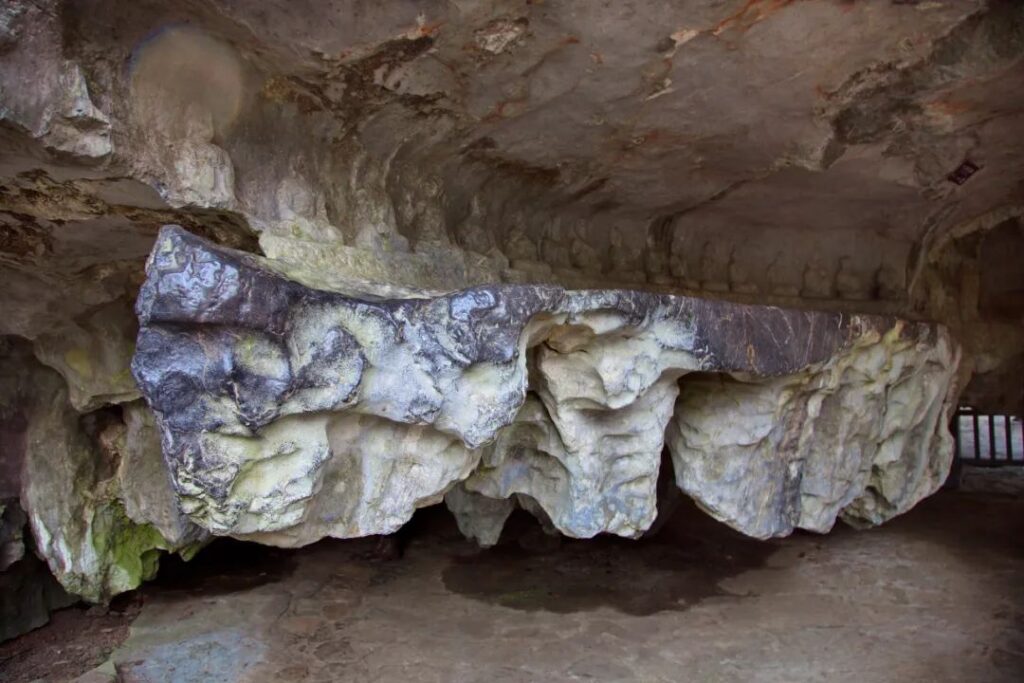
At the entrance of the cave, there is a stone bed called Ji Gong’s Bed. It is said that after Monk Ji Gong became a monk in Lingyin Temple, he often ran out of the temple to drink. When he got drunk, he would fall asleep on the stone bed, snoring. The inner wall of the bed is carved with eighteen Arhats in a row. The Eighteen Arhats are eighteen Arhats who, according to Buddhist legend, permanently reside in the world to uphold the true Dharma. They are all disciples of Sakyamuni.
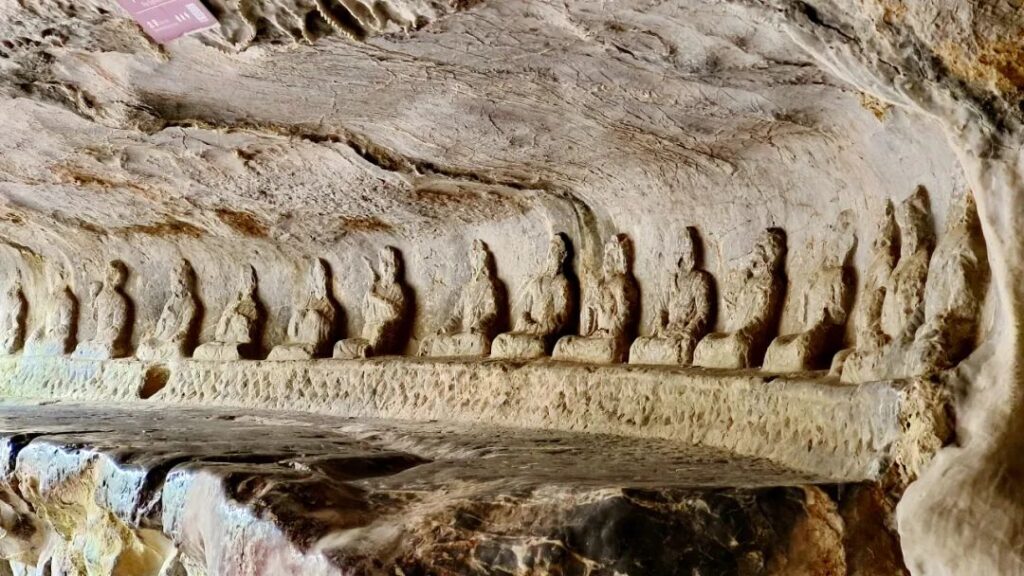
The eighteen Arhats on the inner wall of the bed were all carved in the Northern Song Dynasty. The heads of the eighteen Arhats have been destroyed, and most of them wear cross-collar robes inside and a kasaya with the right shoulder exposed outside. The fifth Arhat from the left raises his bowl with his right elbow bent upward, and on the oblique upper side of the bowl, there is a dragon diving towards the bowl on the rock wall. This Arhat should be the Dragon Subduing Arhat, and it is said that Ji Gong is the reincarnation of the Dragon Subduing Arhat.

Speaking of Monk Ji Gong, there is another legend related to him. When Feilai Peak fell here, Ji Gong thought that this mountain was not down-to-earth and would fly away again, so he carved Arhats on the mountain together with the local villagers, carving a total of five hundred Arhats. With these five hundred Arhats guarding the mountain, Feilai Peak has since sat firmly in front of Lingyin Temple and can no longer fly away.
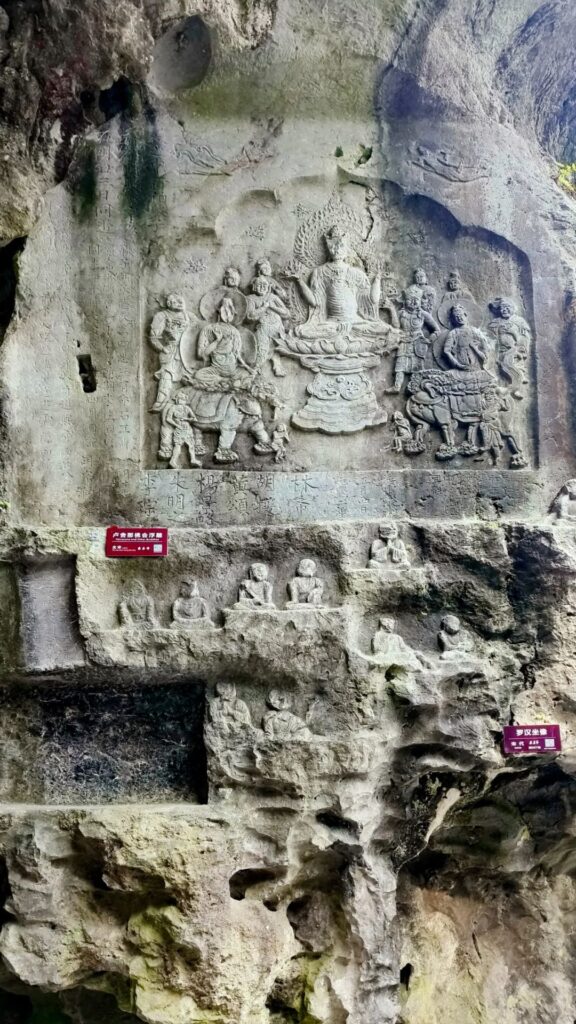
The Vairocana Buddha Assembly statue on the right wall of the cave entrance is the most exquisite work among the Northern Song Dynasty statues, built and offered by a believer surnamed Hu. The Buddha niche is in the shape of a pot door with a flowery head, with 17 large and small relief statues. Vairocana Buddha sits in the center on a lotus seat with his hands raised in a teaching gesture. On the left and right are Manjusri and Samantabhadra Bodhisattvas riding on lions and elephants, and there are also statues of the Four Heavenly Kings, Four Bodhisattvas, celestial beings, and offering figures on both sides.
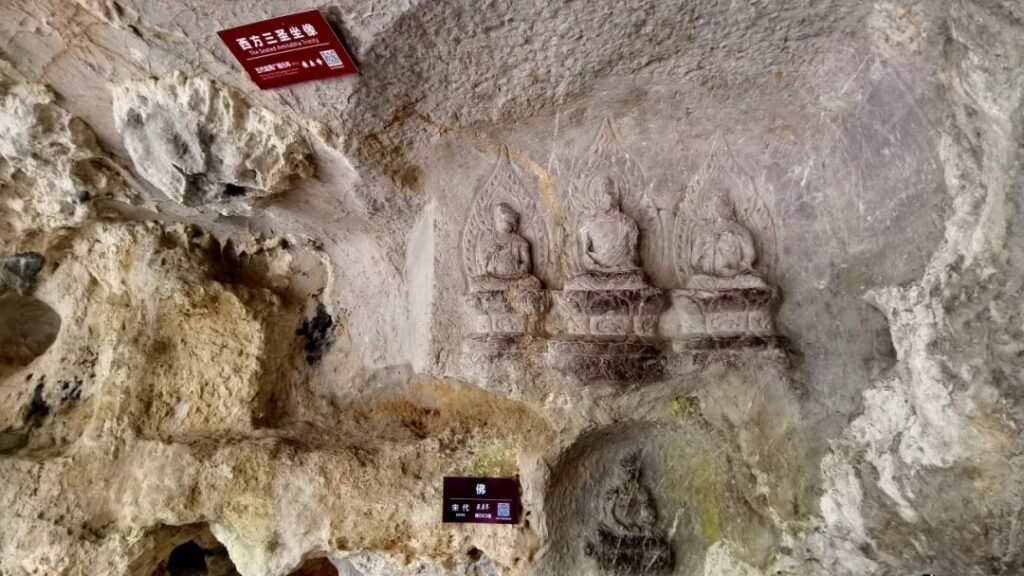
There are three small Buddha statues on the rock wall in the cave, known as the “Three Saints of the West”, carved during the Five Dynasties period. These are the earliest stone carvings in Feilai Peak with inscriptions. The niche is carved with three statues of Amitabha Buddha, Avalokitesvara Bodhisattva, and Mahasthamaprapta Bodhisattva, whose faces have been damaged and all are sitting in full lotus position. The proportions of the three statues are appropriate, and the carvings are meticulous and neat. Although weathered, the exquisite artistic style of the Five Dynasties period can still be seen.

Yuru Cave is the second largest cave in Feilai Peak, named after the milky white limestone solution dripping from the top of the cave. In the past, many bats lived in this cave, so Yuru Cave is also called “Bat Cave”. It is said that Ge Xiaoxian, the grandfather of Ge Hong, a Taoist priest and alchemist in the Jin Dynasty, cultivated and became an immortal in the cave. Yuru Cave is also known as “Yanshi Room”, and there are many stone carvings from the Northern Song Dynasty arranged in the cave.

On the right wall of the entrance, there are carvings of Sakyamuni Triad Buddha and Sakyamuni statues. Above and below, left and right, all the way to other parts of the cave, there are more than fifty Arhat statues carved. These statues are all works from the Song Dynasty, with simple carving techniques. At the bottom of the three Buddha statues, there is an inscription from the eighth year of the Chunyou Wushen era, and most of the smaller Arhat statues have inscriptions from the Xianping era.
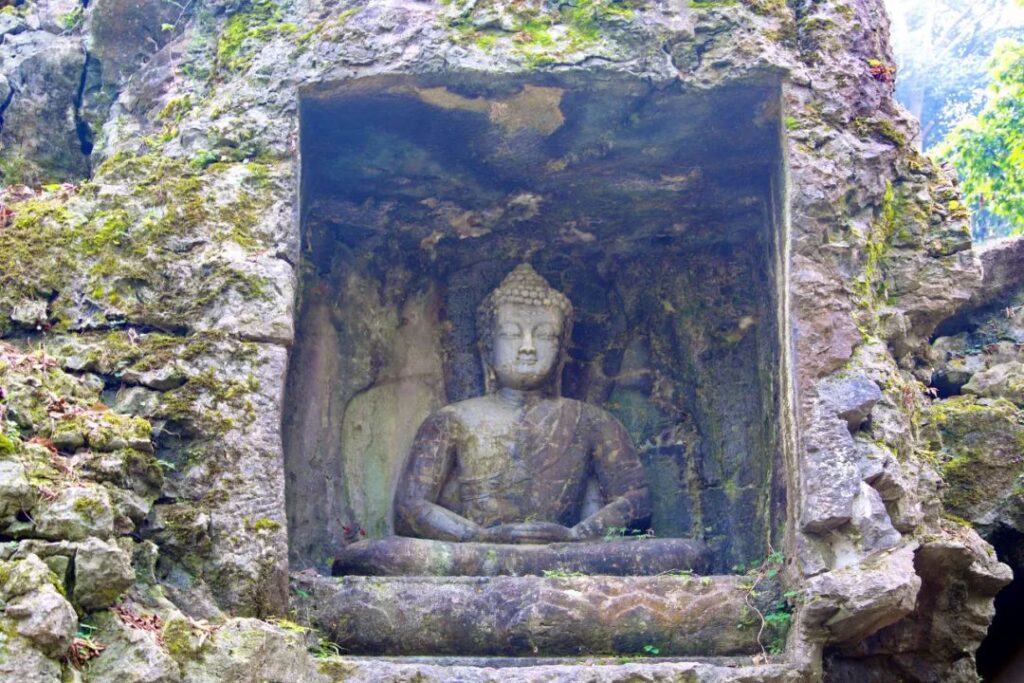
On the cliff face to the east of Yuru Cave, there is a statue of Amitabha Buddha from the Yuan Dynasty. Amitabha Buddha, also known as Infinite Life Buddha, is depicted with both hands in a meditation mudra, sitting in full lotus position, with spiral hair and a steamed bun-shaped usnisa on top of his head. In Tibetan Buddhist Buddha statues, he wears a close-fitting kasaya with the right shoulder exposed, and the entire body is unadorned with clothing folds. The Buddha statue has a high topknot with a jeweled crown on top, which is tall and pointed in shape. Behind the body, there is a plain horseshoe-shaped halo and body halo carved.
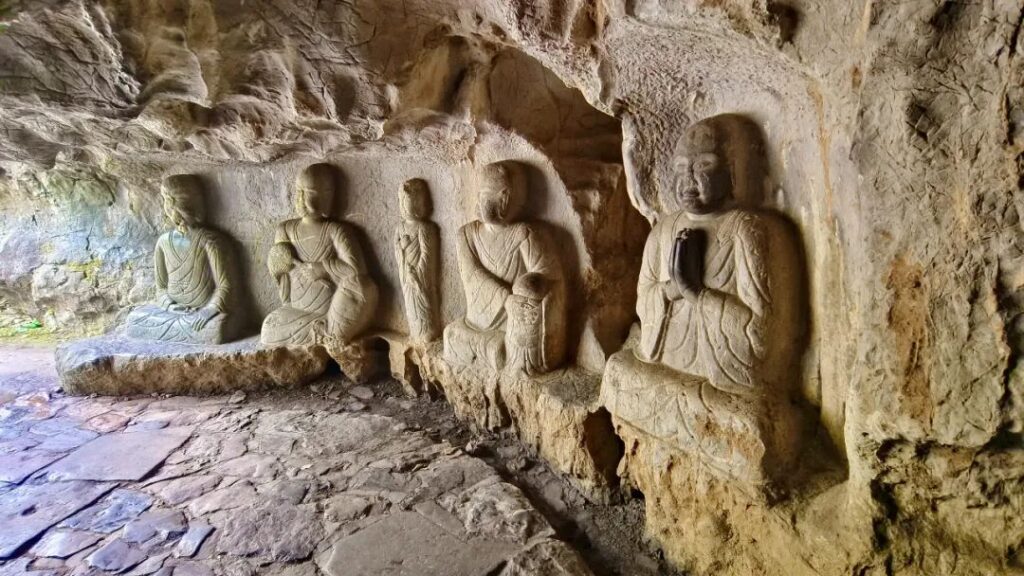
At the north entrance of Yuru Cave, there are six statues of the Six Patriarchs from the Northern Song Dynasty, placed on both sides of the cave entrance. They are the six generations of Zen patriarchs, namely the first patriarch Bodhidharma, the second patriarch Huike, the third patriarch Sengcan, the fourth patriarch Daoxin, the fifth patriarch Hongren, and the sixth patriarch Huineng, collectively known as the “Six Patriarchs of China”.
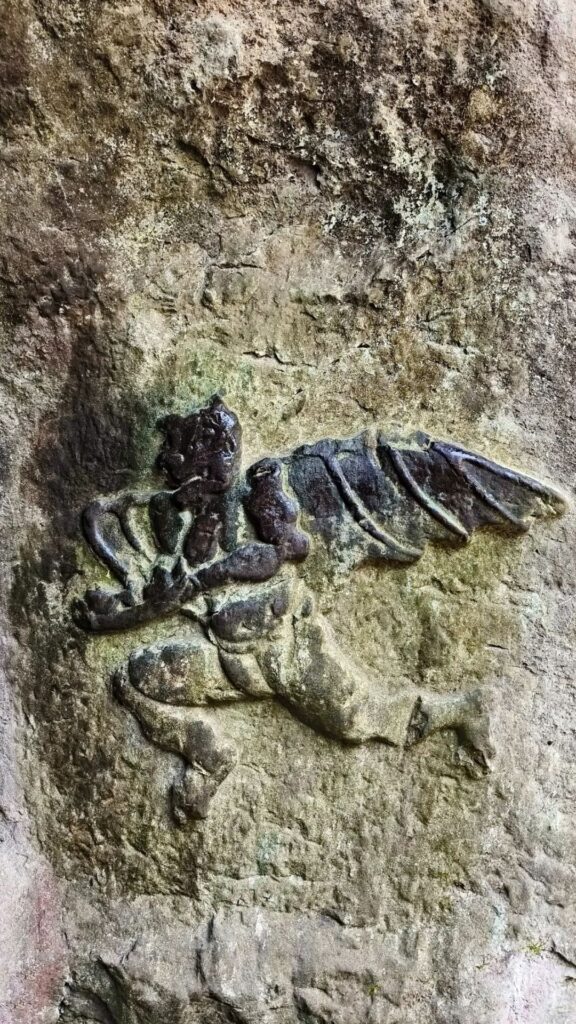
At the entrance of Yuru Cave, there is a relief carving of the Thunder God. The relief is 45 centimeters high, with a tiger head and human body, bare upper body, strong muscles, two wings on the back, wearing long pants and boots. His ears are raised, eyes are wide open, mouth is wide open, wings are spread, and he holds a peach of longevity in his hands, striding towards the direction of the Arhats.

The Ligong Pagoda, also known as the Vulture Pagoda, was built to commemorate Hui Li, the founding patriarch of Lingyin Temple. It is the only surviving pagoda-style building from the Ming Dynasty in Hangzhou. It is said that after Hui Li’s death, his remains were buried under the pagoda. This pagoda was rebuilt in the 18th year of the Wanli era of the Ming Dynasty. The pagoda is solid, with seven stories and six sides. The first floor is the pagoda base, the second floor has the pagoda inscription, the third floor has the Vajra Sutra, and the fourth floor and above have Buddha statues.
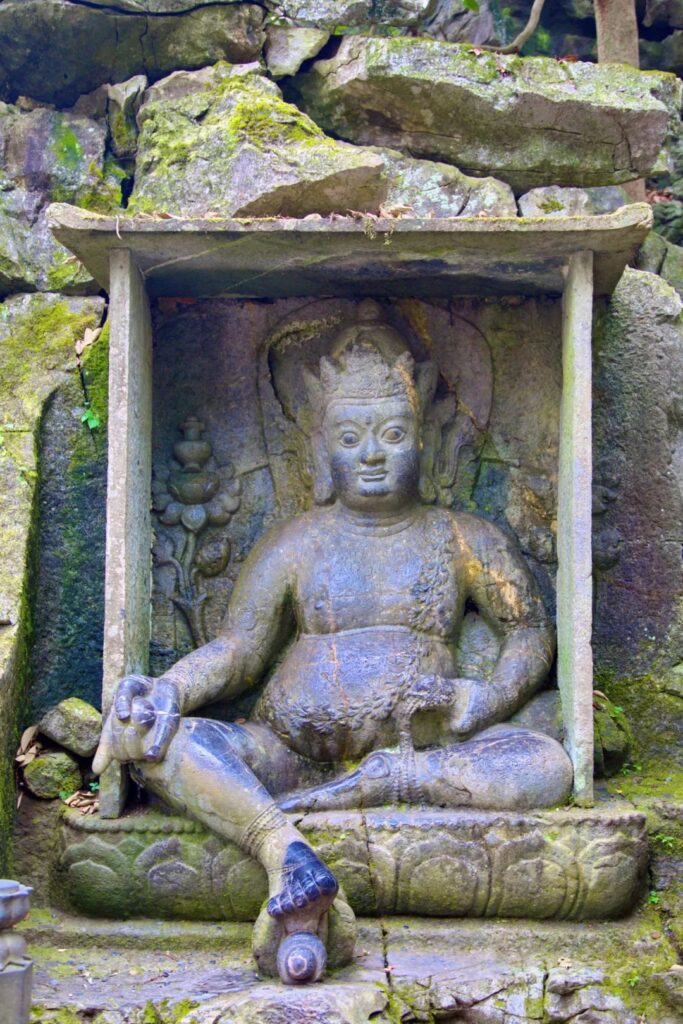
On the north side of the Ligong Pagoda is the statue of the Great Yaksha King of the Treasure Storehouse. This statue was carved in the Yuan Dynasty and is the god of wealth in Tibetan Lamaism, known as the Treasure Storehouse God or Bulujin Vajra. The statue wears a jeweled crown, pendants on drooping ears, big eyes and square jaws, a round and bulging belly, a necklace hanging from the chest and abdomen, and flower bracelets on hands, feet, and wrists. The left foot is curled, and the right foot hangs down and steps on an overturned treasure vase. The right hand holds a round pearl, and the left hand holds a rat-wolf spitting out a string of pearls.

The Vajrapani Bodhisattva is located on the west side of the Ligong Pagoda. This statue was funded and carved by the wife of Tuotuo, a Rong Lu Dafu (Grand Master for Glorious Happiness) and envoy of the Bureau of Tibetan and Buddhist Affairs in the Yuan Dynasty. The Vajrapani Bodhisattva, also known as the Yaksha God, should have a very fierce appearance according to the Tantric sect of Lamaism. However, this Vajrapani Bodhisattva statue wears a jeweled crown, holds a vajra pestle in the right hand, has flying ribbons around the body, and has a face of childlike innocence.
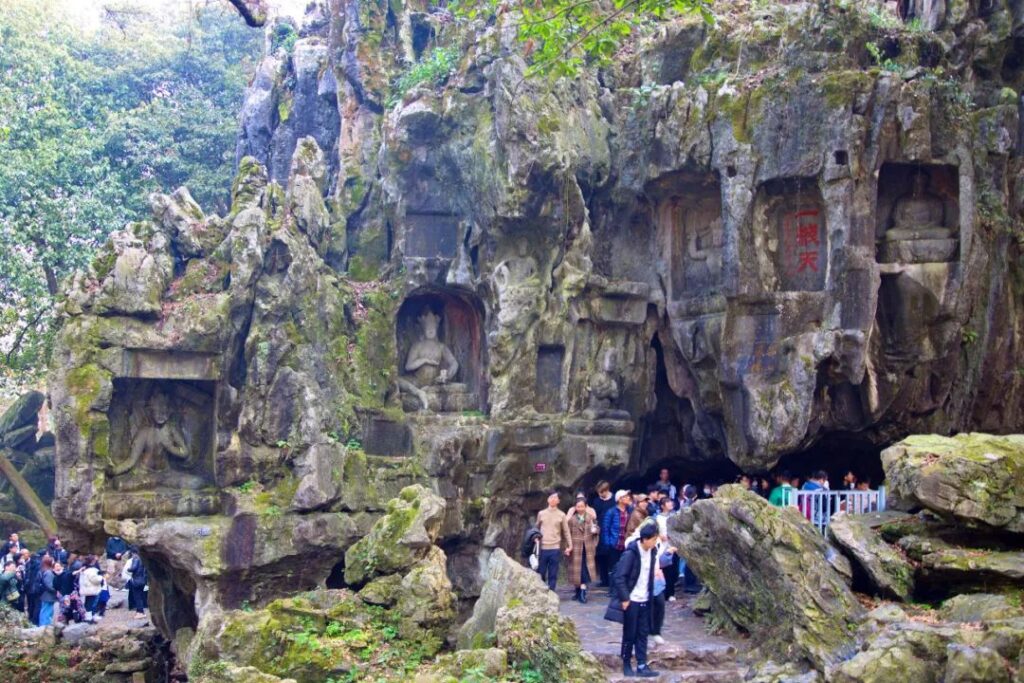
Longhong Cave is one of the three famous caves in Feilai Peak. According to legend, the cave once housed a divine dragon, hence its name. The entrance of Longhong Cave is not grand, but the cave chamber is spacious. There is a well-sized hole in the cave ceiling, through which daylight shines in, so it is also known as the “Tongtian Cave” (Cave to Heaven). The interior of Longhong Cave is dimly lit, giving a sense of unfathomable depth.
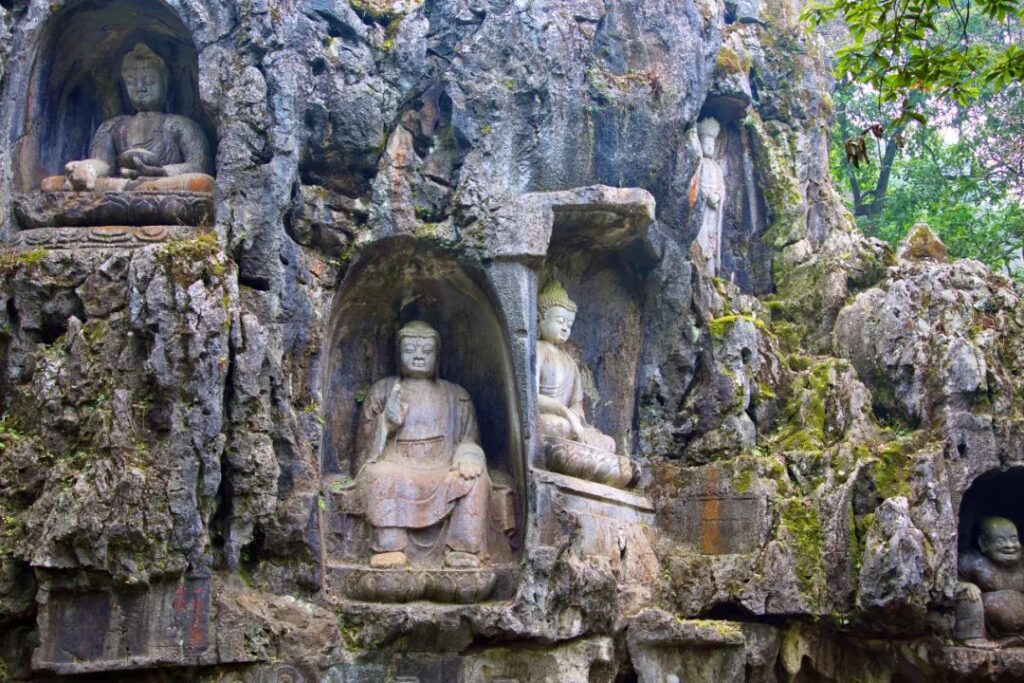
Longhong Cave is the most concentrated area of stone cave statues and cliff inscriptions in Feilai Peak. On the cliff about ten meters high outside the cave, there are many stone cave statues from the early Yuan Dynasty. There are also cliff inscriptions from the Song Dynasty to the Republic of China period, including the seal script of Jiang Zhiqi, the Wei State Duke of the Northern Song Dynasty, and inscriptions by the treacherous minister Jia Sidao of the Southern Song Dynasty and the Southern Song engraver Liao Yingzhong.
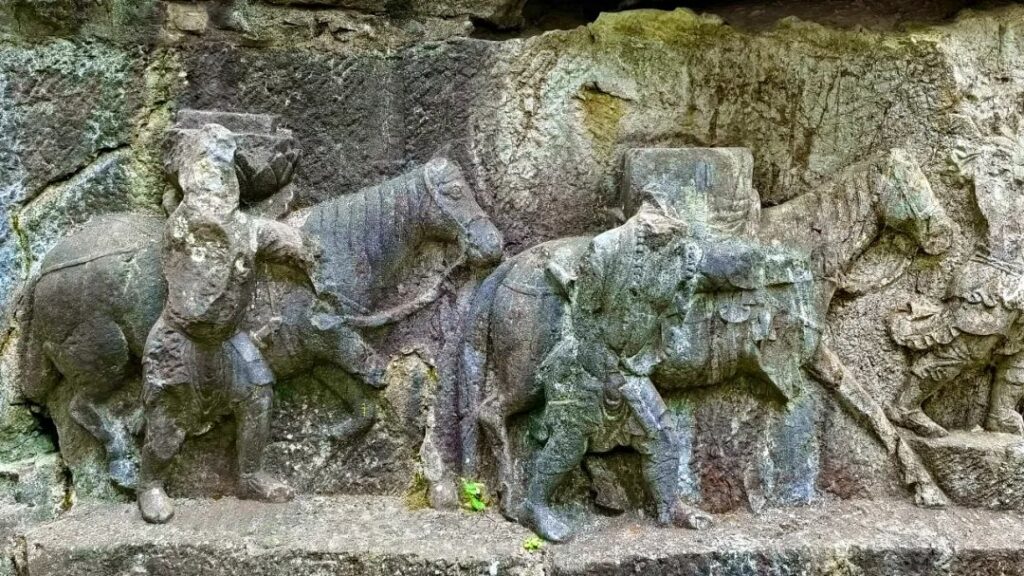
To the right of Longhong Cave, at the bottom of the rock, there are three sets of carvings depicting stories of scripture-seeking journeys. These carvings were made in the Song Dynasty. The first set depicts the story of the Indian monk Kasyapa Matanga and Dharmaratna carrying scriptures on a white horse. The second set depicts the story of Zhu Shixing’s scripture-seeking journey during the Three Kingdoms period. The third set depicts the story of Xuanzang’s journey to the West during the Tang Dynasty. Although the carvings are severely damaged, with some figures only having unclear outlines remaining, they still vividly express the hardships and perseverance of the scripture-seekers on their long journeys.
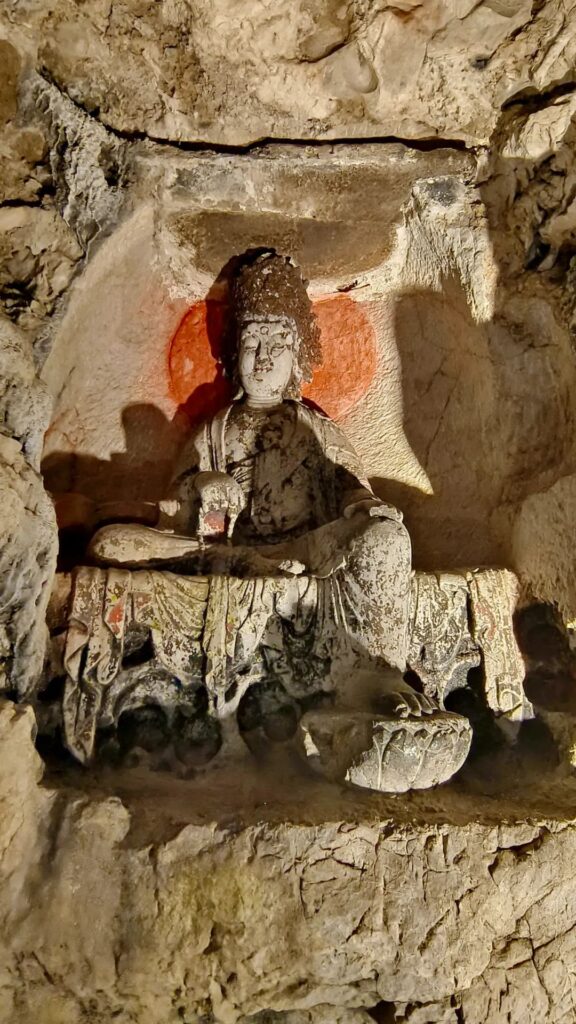
Deep inside Longhong Cave, there is a statue of Avalokitesvara (Guanyin) with prayer beads, so Longhong Cave is also called Guanyin Cave. Avalokitesvara has a compassionate appearance, wearing a jeweled crown, a necklace on the chest, and a thin veil. The right hand holds a string of prayer beads, while the left hand rests on the knee. The right foot is crossed, and the left foot hangs down, stepping on a lotus outside the throne. This is a statue of Avalokitesvara with characteristics of Tibetan Buddhist Tantra.
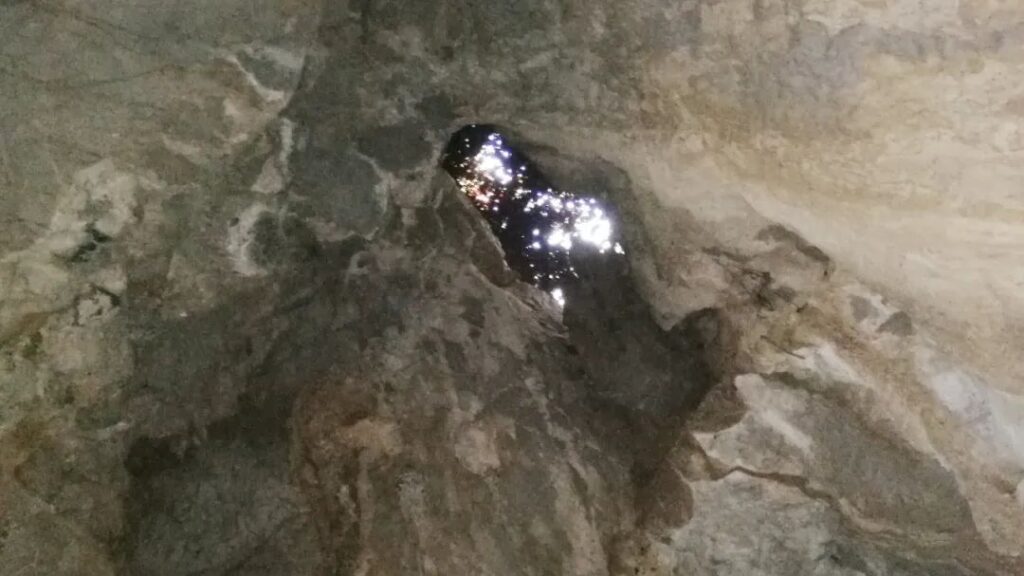
At the top of the cave, near the skylight, there are two unnoticed “Child-Giving Avalokitesvara” statues. Upon closer inspection, one can see that it is a large Avalokitesvara embracing a small Avalokitesvara. These two Avalokitesvaras were naturally formed. Because of these two statues, Longhong Cave is also called the “Child-Giving Cave”. In Hangzhou, the saying “one must go to Lingyin Temple to pray for a child” actually refers to praying to the Child-Giving Avalokitesvara in Longhong Cave.
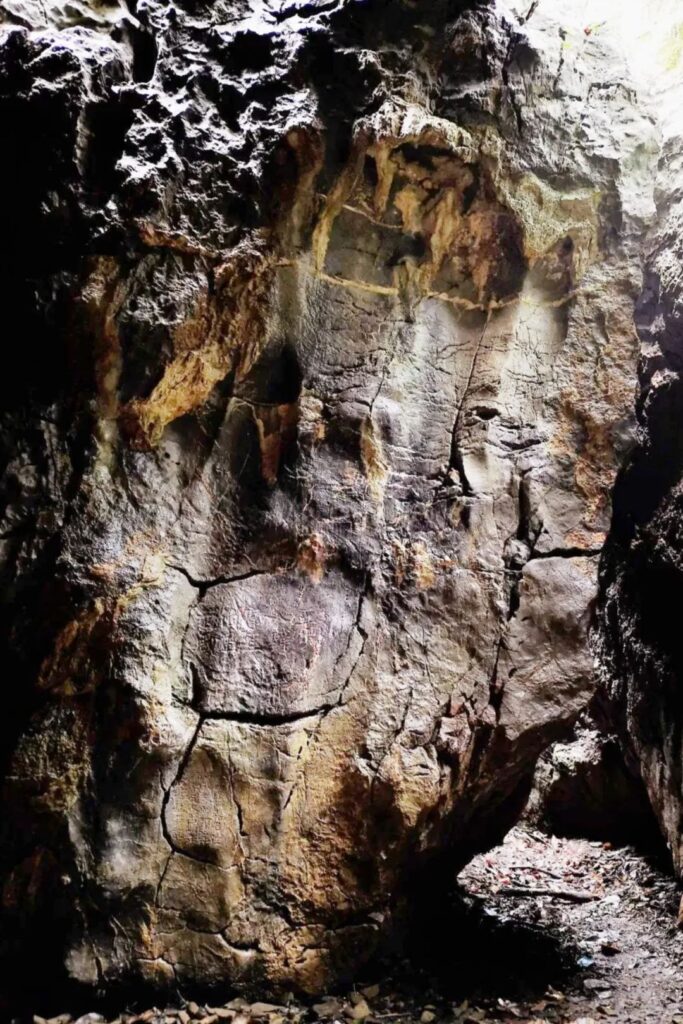
There is also a huge rock in the cave that looks like a “handprint”. It is said that when Feilai Peak flew towards Lingyin Temple, although the villagers had been called out by Ji Gong, there was still a child running at the back. Just as the mountain peak was about to crush the child, in a critical moment, Ji Gong pushed the mountain peak away by several feet with his palm, saving the child, and leaving Ji Gong’s handprint on the cliff.
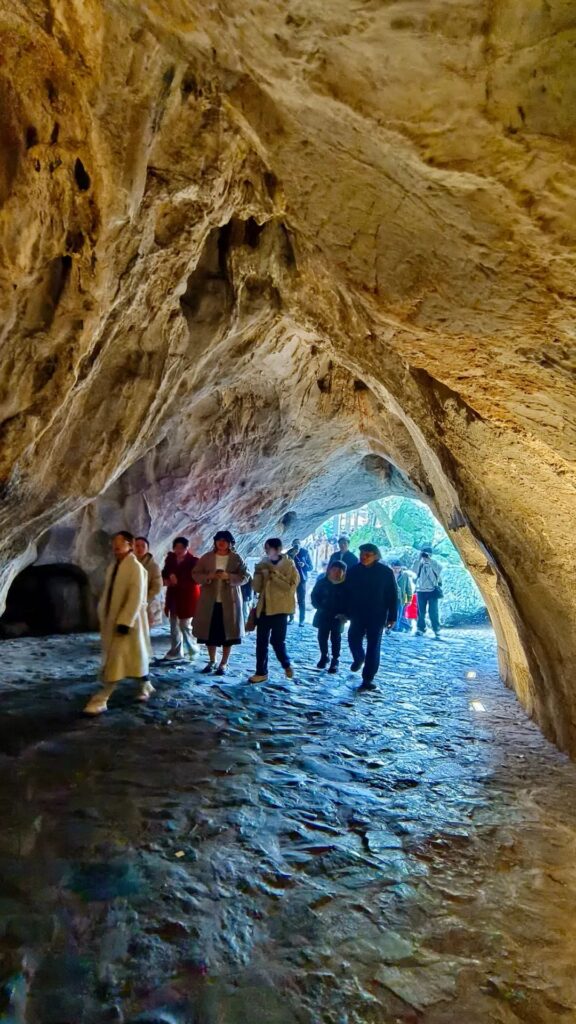
Shexu Cave is a small cave to the left of Longhong Cave and is also a famous “One Line Sky” in Feilai Peak. It is said that if you look up from inside the cave and stand in just the right position, you can see a pinhole-sized light through the thick rock wall. If you stand slightly off position, the light disappears. Therefore, people believe that those who can see the “One Line Sky” will have particularly good luck that year.

On the cliff outside the One Line Sky, many stone niches have been carved. The statue of Vajrasattva Bodhisattva, carved in the Yuan Dynasty, is a Tibetan Buddhist statue. Vajrasattva Bodhisattva wears a jeweled crown, has three eyes on the face, a slightly open mouth revealing teeth, and furrowed eyebrows. The left hand holds a vajra bell placed on the thigh, while the right hand holds a cross-vajra in front of the chest. The right foot extends out of the throne, with the toes stepping on a multi-petaled inverted lotus pedestal. Behind the body, there are fluttering sacred ribbons and a halo in the shape of a ring.
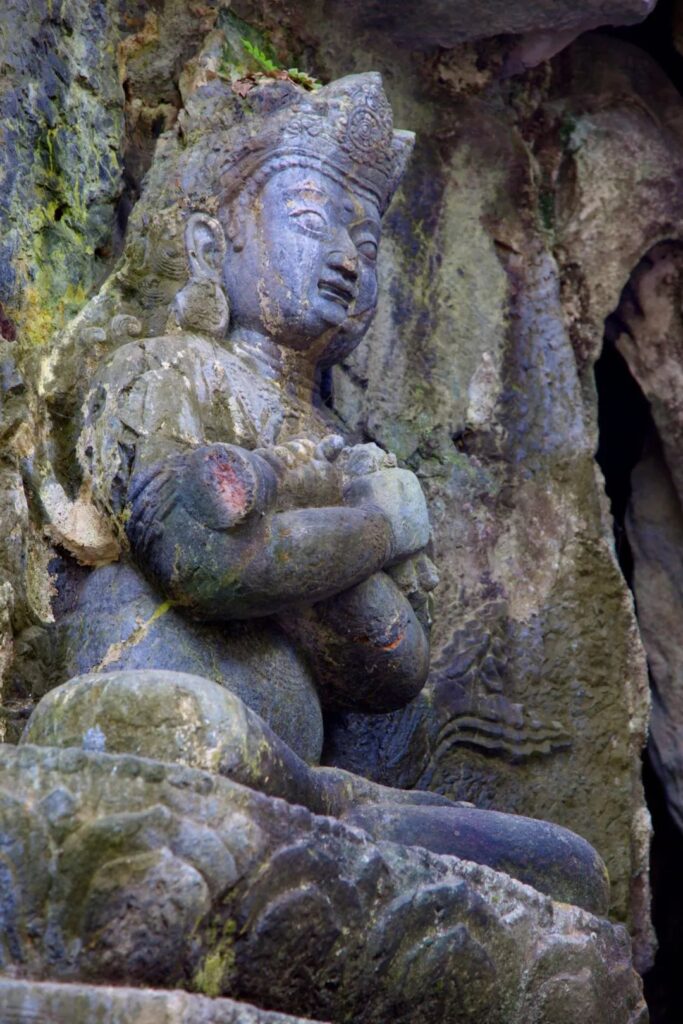
The statue of Mahamudra Vajrapani is located at the entrance of the One Line Sky. The statue wears a pointed crown, has a square jaw and round face, round wide-open eyes, long hair falling over the shoulders, and earrings hanging from the earlobes. The upper body is bare, with a necklace on the chest, and both hands wearing bracelets. The left hand holds a vajra bell, while the right hand holds a vajra pestle, crossed and held in front of the chest. The statue is in a full lotus position, with bare feet and exposed toes, sitting on a lotus throne.

In the deep shade of the green trees at the western foot of Feilai Peak, an underground spring gushes out to form a small stream, which is the famous Cold Spring Stream of Feilai Peak. The water of the Cold Spring is crystal clear like jade, and it gushes continuously regardless of the dry or rainy season, splashing like pearls and jade, as if playing heavenly music. The Ming Dynasty painter Shen Shitian wrote in a poem: “The scenery of the lake is said to be in Lingyin, but the best scenery is only found at the Cold Spring.”
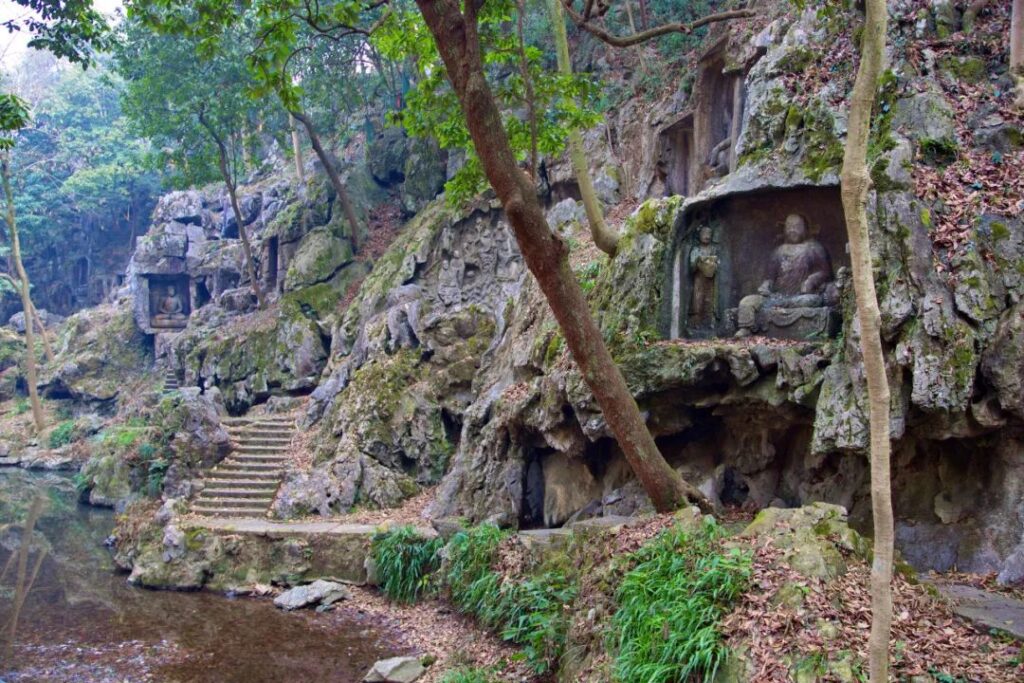
On the cliffs of the southern bank of the Cold Spring Stream, many stone cave statues are scattered. Walking along the stone path on the cliffs and enjoying the scenery gives a feeling of a Jiangnan garden. The statues along the path, seemingly similar in appearance, reveal different moods as one moves along. The strange rocks are rugged, and the trees are lush. With the statues dotted in between, it is like a Buddhist light in the mountains, serene yet lively, allowing people to feel more of the cultural charm in nature.
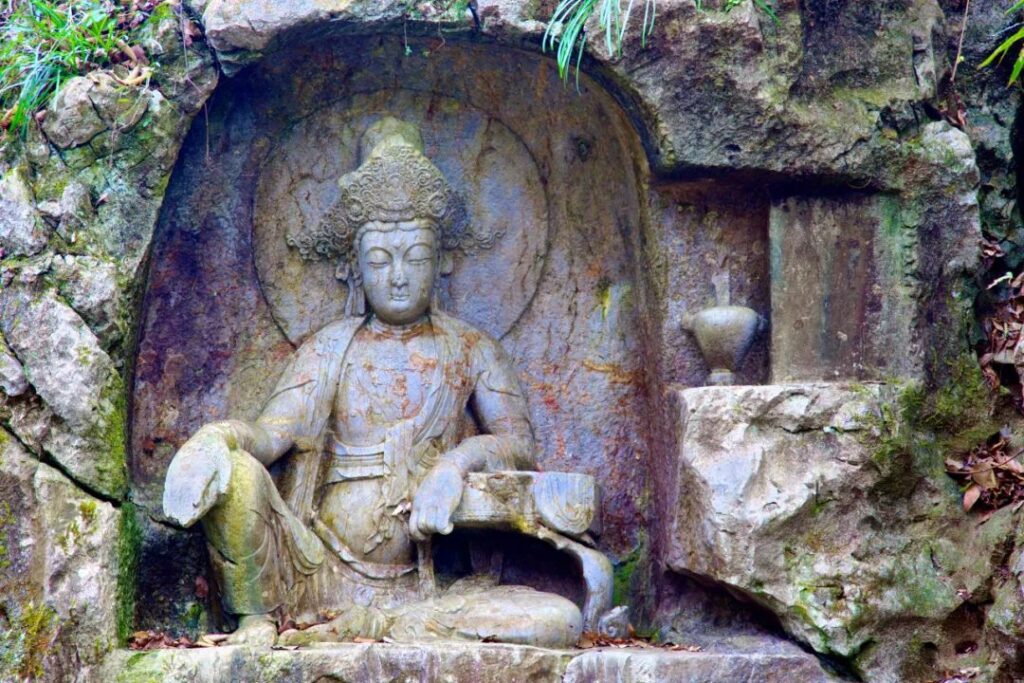
The Water-Moon Avalokitesvara statue beside the Cold Spring Stream was carved during the Yuan Dynasty Zhiyuan period. The Water-Moon Avalokitesvara has a young female appearance, wearing a jeweled crown with a transformative Buddha making a hand-clasping gesture in the crown, and a circular halo behind the body. The statue has sacred ribbons draped over the shoulders, delicate eyebrows and eyes, a close-fitting necklace, and a full-bodied and compassionate appearance. Both hands wear bracelets, with the right hand pressing on the knee and the left hand holding a string of prayer beads. The right foot is raised, and the left foot is crossed.
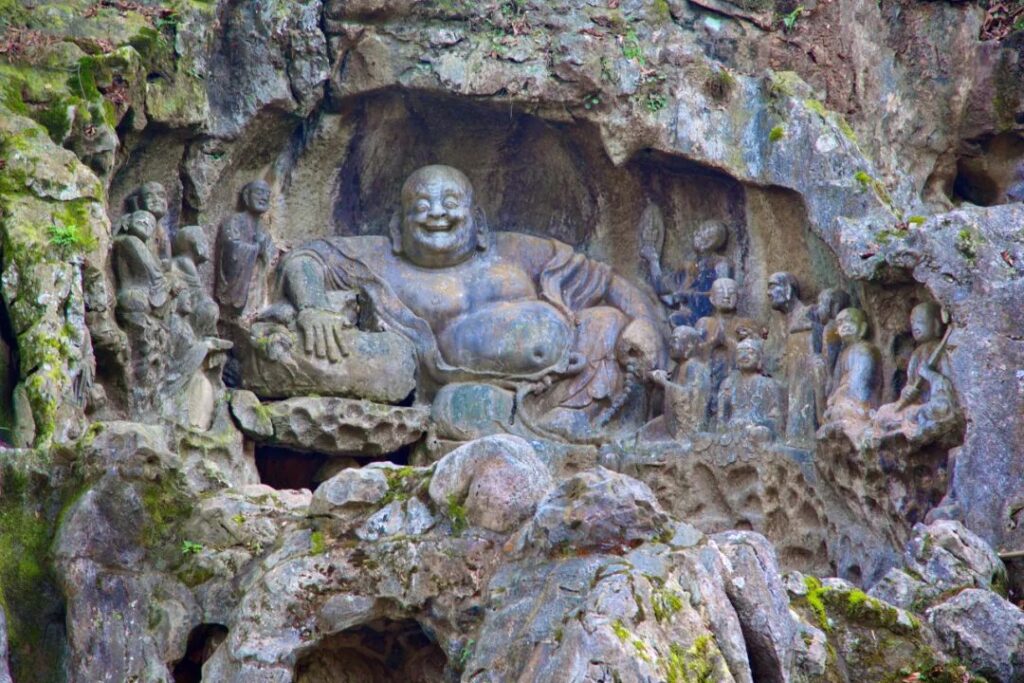
The statues of Maitreya and the Eighteen Arhats were carved during the Southern Song Dynasty and are the most famous group of statues in Feilai Peak. Maitreya has a fat head and big ears, full double chins, a bare chest and belly, and sits barefoot with his right hand supporting a cloth bag and his left hand holding prayer beads. The diagonally draped kasaya robe, the dense folds of the garment, and the relaxed sitting posture, together with the depiction of the face, create a realm of transcending the mundane world, enjoying oneself, doing as one pleases, and being free and at ease.
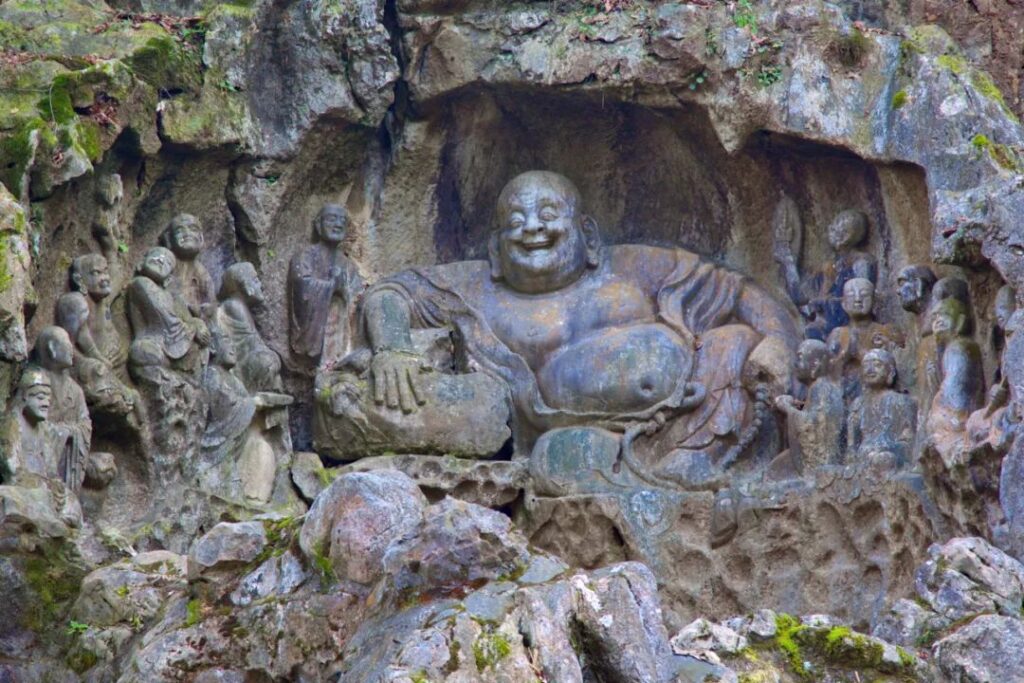
Surrounding Maitreya on both sides are the Eighteen Arhats, either sitting, standing, or lying down, each with a different posture and expression. The objects they hold are also different, some holding pagodas, some with palms together, some holding tin staffs, some unfolding scriptures, and some holding ruyi scepters. The statues use exaggeration and realism to give each Arhat a unique personality, making them appear relaxed, humorous, and secular.
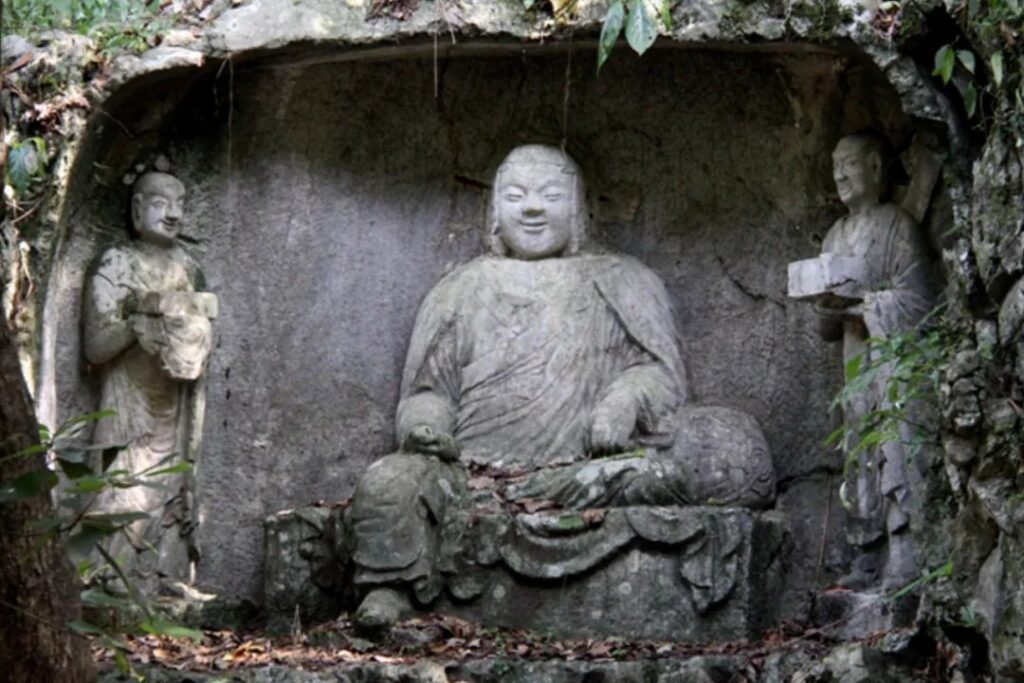
Not far from the Maitreya statue, there is a niche with one main and two accompanying statues, which are said to have been made by the evil monk Yang Lian Zhenjia for himself. Yang Lian Zhenjia was appointed as the Chief Administrator of Buddhism in Jiangnan after the Yuan army conquered Lin’an. After arriving in Jiangnan, he destroyed the temples of the Han region and built Tibetan Buddhist holy statues. He also excavated the imperial tombs of the six emperors of the Southern Song Dynasty, burying the remains of the emperors at the former site of the imperial city and building the Zhennan White Pagoda on top of it. He even cut off the head of Emperor Lizong of the Song Dynasty and made the skull into a vessel for holding wine.
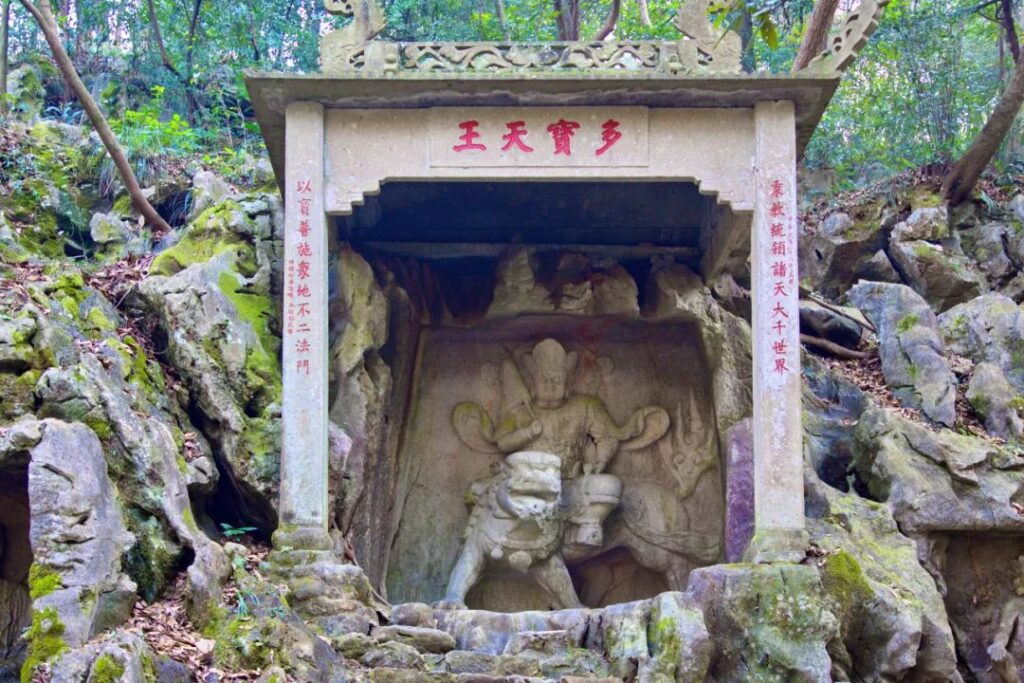
At the end of the stone bridge over the Cold Spring Stream, there is a stone cooling pavilion with the four red characters “Duobao Tianwang” (Vaisravana Heavenly King) engraved above it. On the two stone pillars on the sides, there is a couplet that reads, “Upholding the teaching, commanding all the heavens and the great thousand worlds, using treasures to bestow kindness and give to all, the non-dual Dharma gate.” Inside the stone niche in the cooling pavilion, the Vaisravana Heavenly King wears a jeweled crown and armor, holds a treasure staff in his right hand, and grasps a treasure-spitting mouse that can spit out endless treasures in his left hand, riding on a Pixiu (a mythical creature).
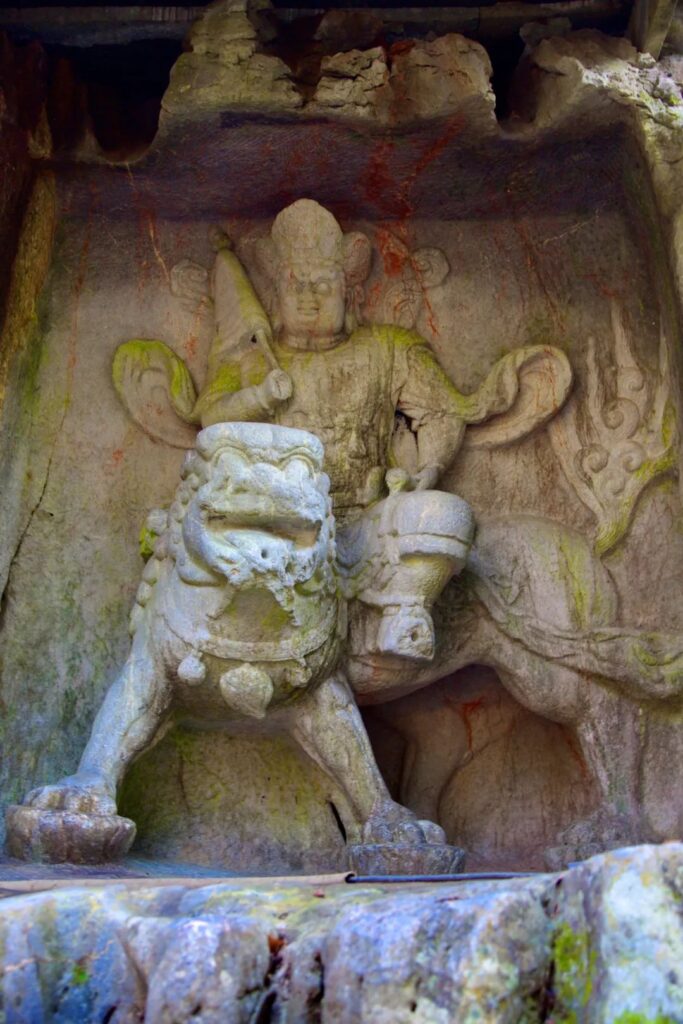
Vaisravana, also known as Pishamenten, is one of the Four Great Heavenly Kings who protect the Dharma. Because his duty is to protect the Tathagata’s place of practice, he often has the opportunity to hear the Tathagata preach the Dharma, so he is also called the Heavenly King of Great Learning. He is also in charge of wealth and is a benevolent deity who controls treasures and riches. In Tibetan Tantra, he is revered as the God of Wealth. Because he can bestow blessings, wisdom, and benefits to all beings, he is also worshipped as one of the Seven Gods of Fortune.
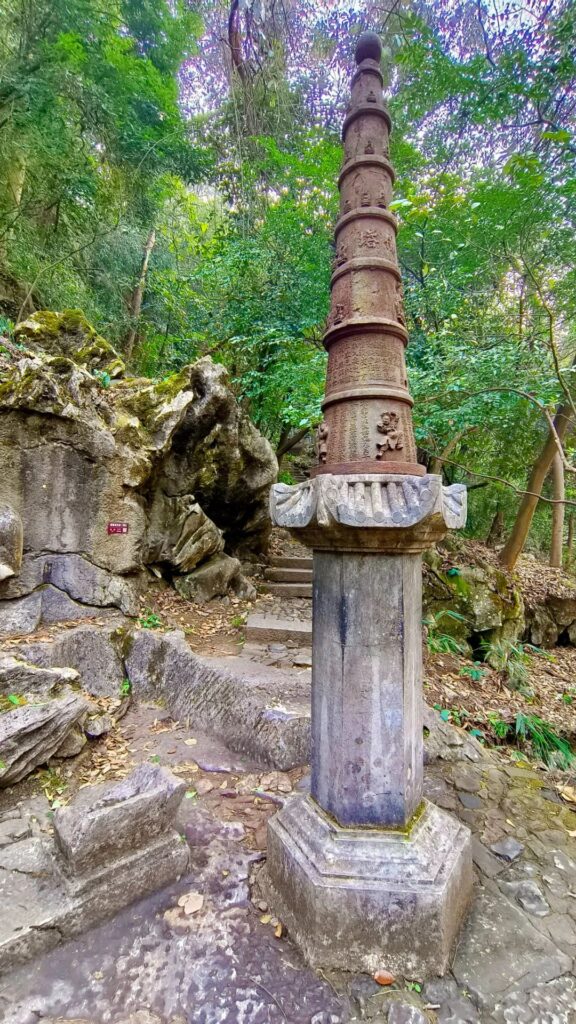
The Duobao Pagoda is a sutra pillar-style pagoda built during the Qing Dynasty. It is a small and exquisite mixed structure of iron and stone segments. The lower part of the pagoda is a six-sided sutra pillar, with the pillar body carved from bluestone and the top of the pillar having a hexagonal stone-carved flying eave. The upper part of the pagoda is a seven-level conical Buddhist pagoda cast in wrought iron, with Buddha statues cast on the upper five levels and inscriptions on the lower two levels describing the origin and process of the pagoda’s donation and construction.
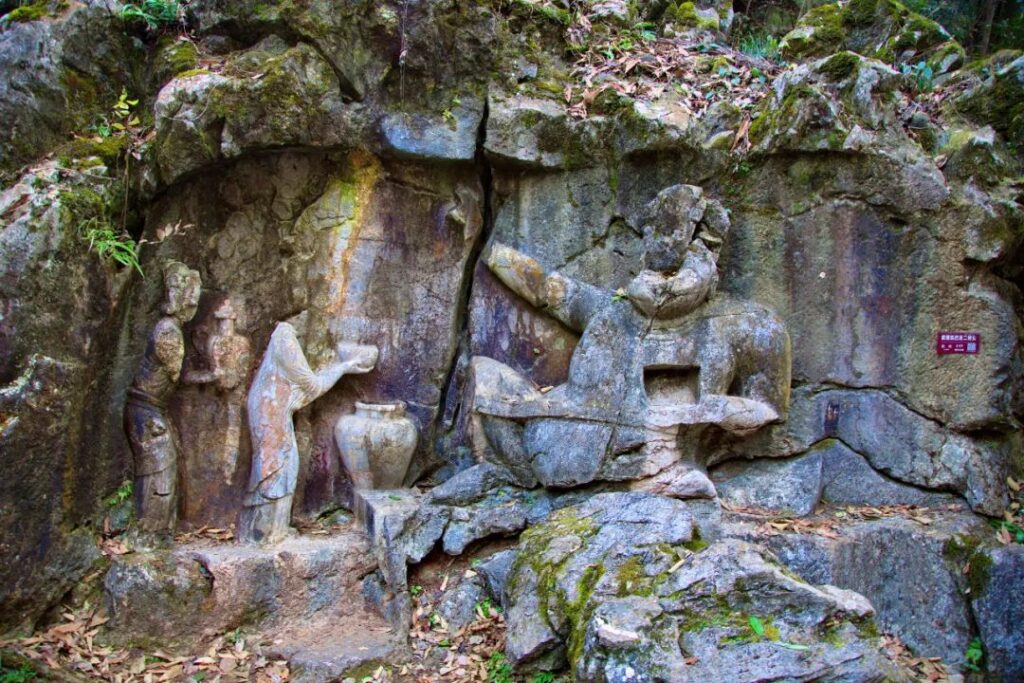
On the cliff wall next to the Duobao Pagoda, there are statues of Milarepa and his two female attendants. This group of statues is the most mysterious Yuan Dynasty carving in Chinese grotto art, depicting the story of the victory of the Dharma protector deity Milarepa in Tibetan Buddhism and his attendants presenting him with wine. The two female attendants are draped in shawls and have beautiful postures. The one in front has a damaged head and holds a bowl with both hands, while the one behind holds a ewer. They stand respectfully in front of Milarepa, one in front of the other, holding wine.
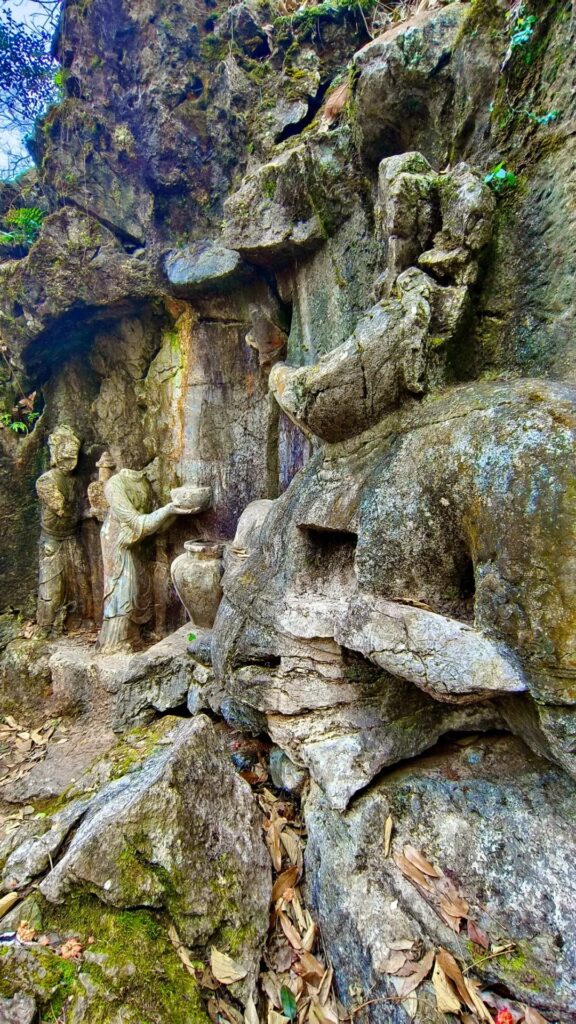
The main deity, Milarepa, has a naked and robust body, with his head slightly raised, his right arm raised and extended forward, and his left arm placed in front of his chest. His left leg is crossed, and his right leg is raised, sitting on a low and flat stone platform with his body leaning back. A cloth belt is tied around his right leg and waist, and he wears numerous decorations such as bracelets, armlets, and anklets. Milarepa’s head and body are damaged in many places, and his facial features are unrecognizable.
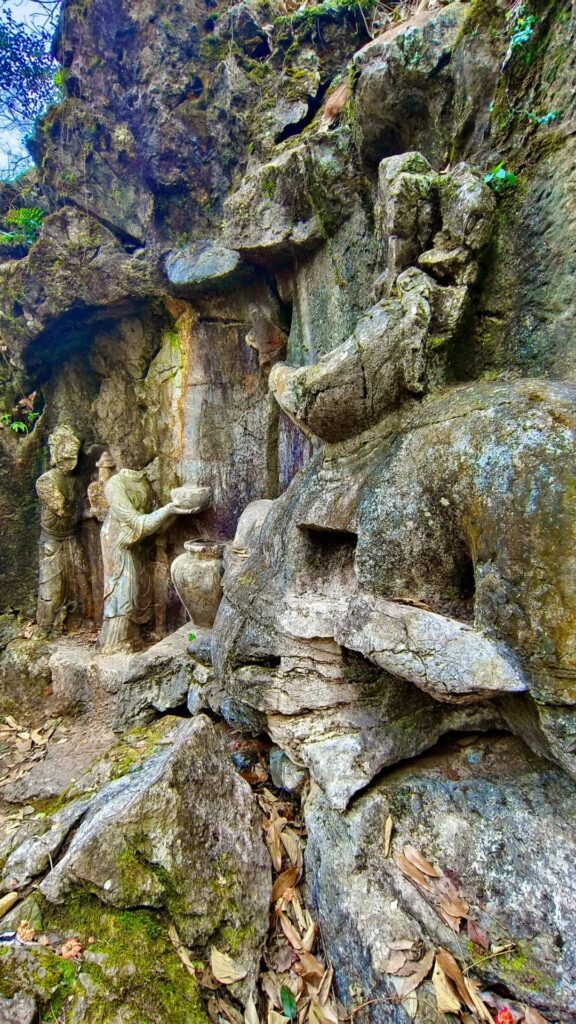
According to the records of the Ming Dynasty literatus Zhang Dai in his book “Gaoding Shanfang Xiaoji,” this group of statues was damaged by him. In the fourth year of the Tianqi era of the Ming Dynasty, Zhang Dai and Chen Hongshou, among others, were studying in Lingyin. Due to the instability of the situation at the end of the Ming Dynasty and the beginning of the Qing Dynasty, Zhang Dai and others were troubled and restless. Seeing a Persian barbarian here, with a barbaric woman offering wine on the side, they thought it was a statue made by the evil monk Yang Lian Zhenjia of the Yuan Dynasty. They couldn’t help but become angry, took a large hammer, and smashed the statue.
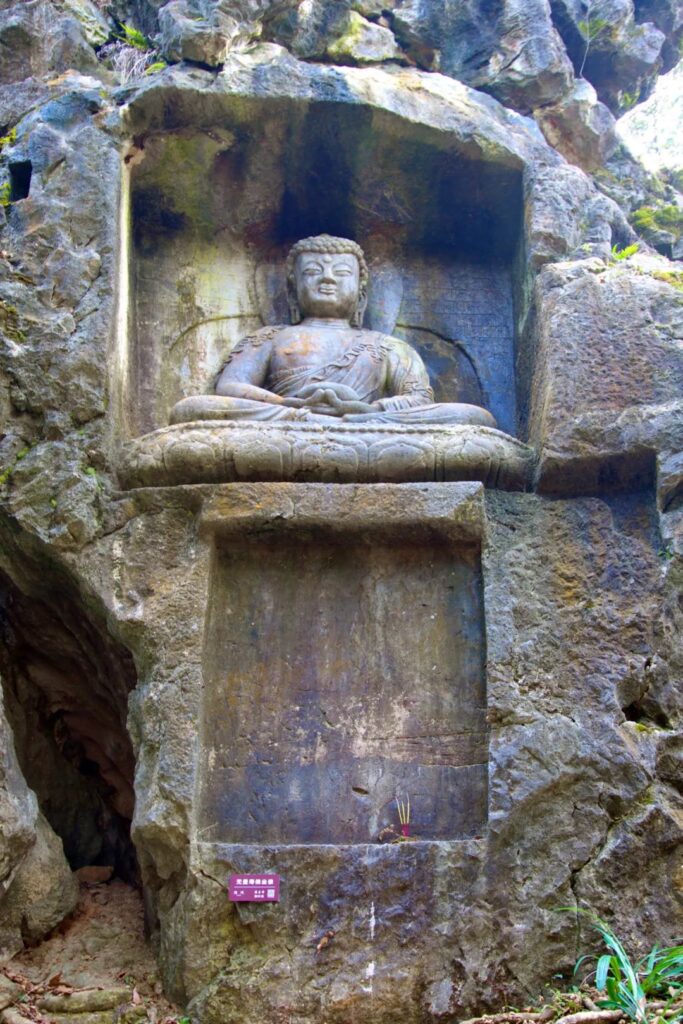
The statue of Amitayus Buddha is located on the southern bank of the Cold Spring Stream and was carved during the Zhiyuan period of the Yuan Dynasty. Amitayus Buddha has a spiral topknot and a fleshy protuberance on the top of his head, with slightly open eyes and a compassionate face. The entire statue has a plump body, broad shoulders, and a thin waist, wearing a half-shouldered kasaya robe, exposing the right chest and shoulder. The hands are folded in the Samadhi mudra, supporting a bowl. The feet are crossed and placed on the left and right thighs, in a full lotus position.
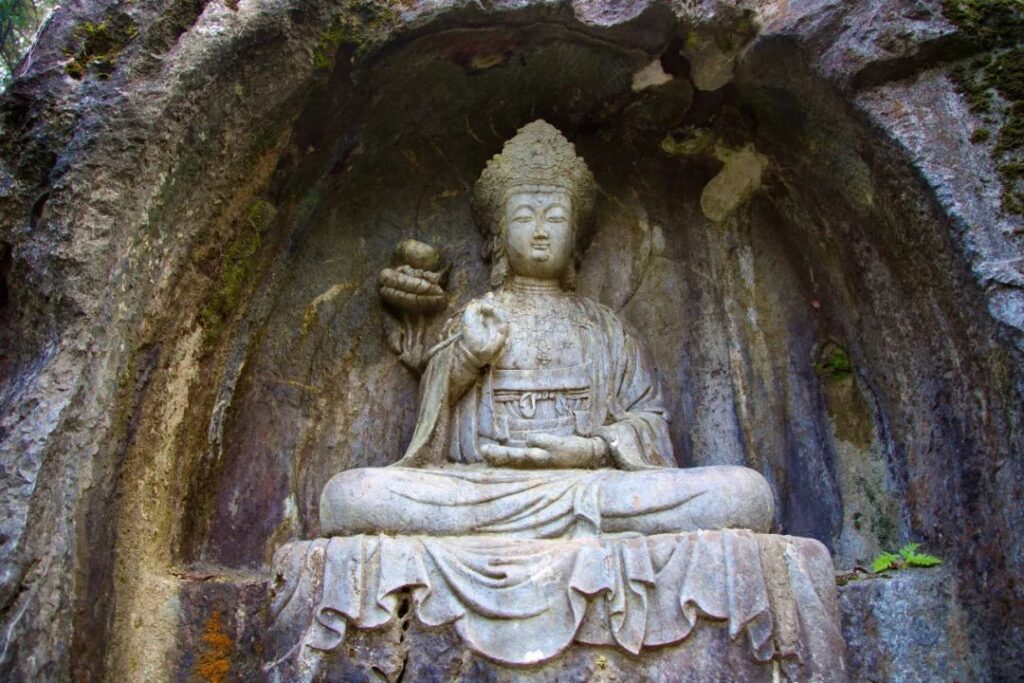
The statue of Avalokitesvara Bodhisattva on the small path on the southern bank of the Cold Spring Stream is a Yuan Dynasty statue. The Avalokitesvara Bodhisattva statue has a youthful female appearance, wearing a jeweled crown, with sacred ribbons draped over the shoulders and earrings hanging from the ears. The eyebrows are clear, and the eyes are beautiful. The statue wears a robe with a center closing, holds an object in the left hand placed in front of the navel, and holds a lotus in the right hand. The statue is in a cross-legged sitting position, with the full lotus posture not revealing the toes, sitting upright on a platform, and the lower hem of the kasaya robe covers the top of the flat seat.

The statue of Sakyamuni Buddha has a fleshy protuberance and spiral hair on the top of the head, with long ears touching the shoulders and slightly open eyes. There is a white curl between the eyebrows. The face is compassionate, and the body is plump, wearing a full-shouldered kasaya robe. The left hand bends the thumb and extends the other fingers, placed in front of the navel; the thumb and ring finger of the right hand are joined to form a wheel shape, raised in front of the chest. The statue is in a full lotus position, sitting upright on an inverted lotus seat.
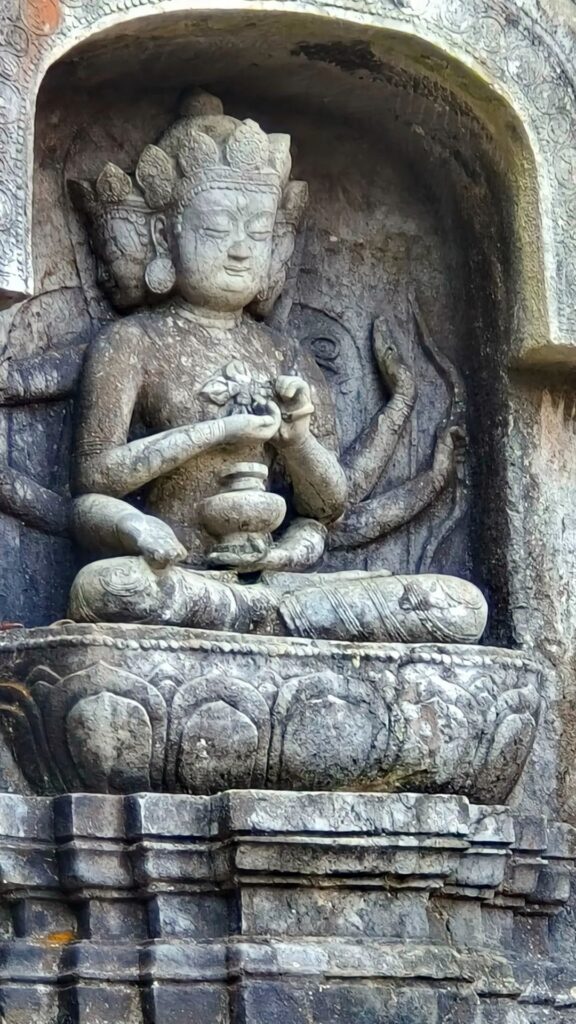
Among the many statues at Feilai Peak, the most exquisite should be the Usnisavijaya Buddha Mother altar niche from the early Yuan Dynasty. Usnisavijaya, also known as “Tara” or “Buddha Mother,” is a unique goddess in Tibetan Buddhism. She is the incarnation of Avalokitesvara Bodhisattva and can appear before people in twenty-one different forms, with different colors, different Dharma instruments held in her hands, and different names.

Among all the statues at Feilai Peak, there are many Tara statues with different names, and the Usnisavijaya statue is one of the higher-quality creations. The niche is in a convex character shape, with a lama pagoda carved in the center. At the bottom is an inverted lotus seat on a ya-shaped Sumeru pedestal. Usnisavijaya has three faces and eight arms, wears a jeweled crown, has a bare upper body, and wears a long skirt on the lower body. She holds various Dharma instruments in her hands and sits upright on a lotus treasure seat. Around Usnisavijaya, there are also eight carvings of attendant bodhisattvas, dvarapalas, and offering apsaras.
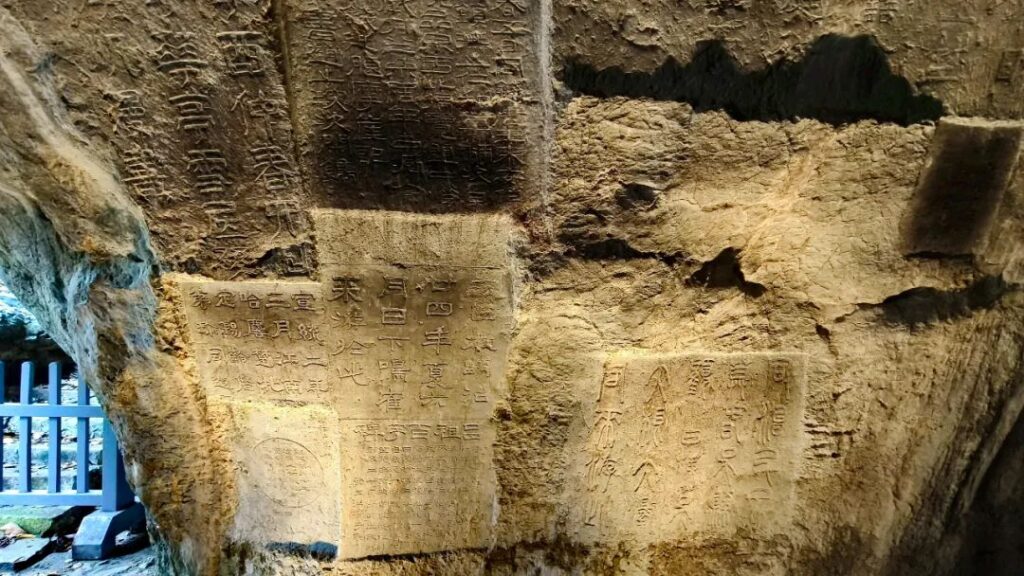
In addition to preserving numerous stone carvings from various dynasties, Feilai Peak also has a large number of cliff inscriptions, making it a treasure trove of ancient Chinese calligraphy. These cliff inscriptions scattered on the rocks were created by ancestors with each stroke and cut, endowing the cold stones with cultural connotations. These stone books stand amidst the mountains and waters, on the cliffs, recording the footsteps of historical changes.

Visiting Feilai Peak, you will feel that there is no stone that is not strange, no tree that is not ancient, and no cave that is not secluded. The weird rocks are towering, the ancient trees are lush, and there are caves and valleys everywhere. Its scenery is vastly different from the surrounding peaks. Wandering in the deep Buddhist atmosphere of Feilai Peak, searching for and fully appreciating the charm of Buddhist art, one can truly feel the rich historical and cultural charm contained within the landscape of West Lake.
